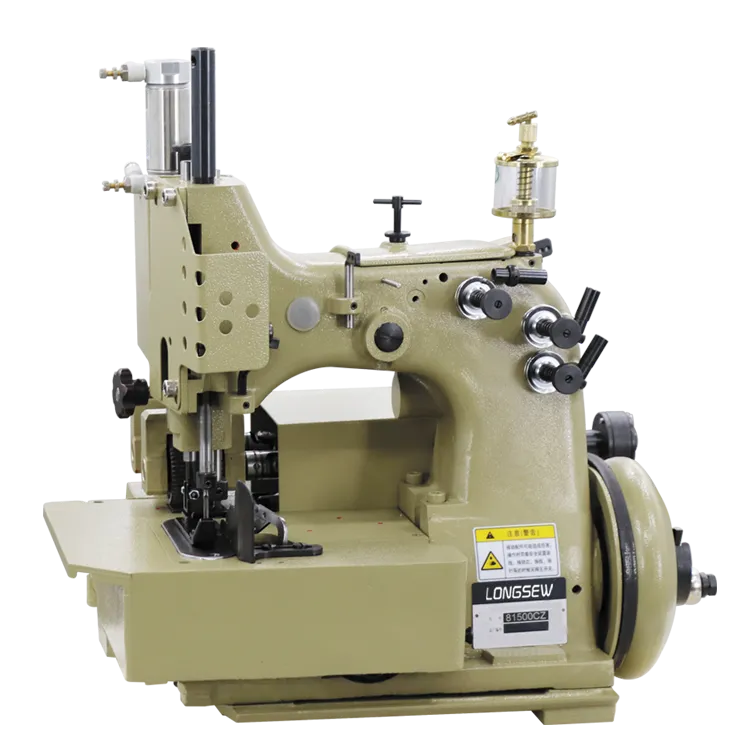Versatile Industrial Sewing Machines for Straight and Zigzag Stitching Applications
The Evolution and Importance of Industrial Sewing Machines Straight and Zigzag Stitches
Industrial sewing machines have played a crucial role in the textile and garment manufacturing industries, providing speed, efficiency, and precision in stitching fabrics. Among the various functionalities offered by these machines, straight and zigzag stitches are fundamental to a myriad of applications—from basic garment construction to intricate decorative work. In this article, we will explore the evolution, significance, and applications of straight and zigzag stitches in the world of industrial sewing.
The Evolution of Industrial Sewing Machines
The history of sewing machines can be traced back to the early 19th century when the first patent for a sewing machine was granted to Elias Howe in 1846. This invention marked the beginning of a revolutionary change in the textile industry, enabling manufacturers to produce garments at an unprecedented rate. As technology advanced, the sewing machines evolved, leading to the creation of industrial sewing machines designed specifically for high-volume production.
Today, industrial sewing machines are equipped with advanced technologies, including computerized systems that enhance their capabilities. They can handle various types of stitches, with straight and zigzag being the most commonly used. While straight stitching is essential for basic seams, zigzag stitching offers versatility for various applications, including finishing edges and decorative purposes.
Understanding Straight Stitches
Straight stitches are the most fundamental type of stitching used in sewing. The machine creates a straight, single line of stitching, which is, in many instances, the backbone of garment construction. These stitches can be used to join two pieces of fabric, hem raw edges, or create darts and pleats. The strength and durability of straight stitches make them ideal for seams that undergo considerable stress, such as the side seams of trousers or the shoulder seams of dresses.
Industrial sewing machines designed for straight stitches often operate at high speeds, allowing manufacturers to produce garments rapidly. Stitch quality is essential, as it affects not only the aesthetic appeal of the finished product but also its durability. High-quality industrial straight stitch machines can produce perfectly even stitches, ensuring that the seams are both functional and visually appealing.
industrial sewing machine straight and zig zag

The Versatility of Zigzag Stitches
In contrast, zigzag stitches feature a back-and-forth pattern, creating a zigzag effect. This versatile stitch can perform a wide range of functions in garment construction. One of the primary uses of zigzag stitching is to prevent fraying at the edges of fabrics, especially for knit materials that may stretch. When zigzag stitches are used for finishing edges, they create a neat, finished appearance while enhancing the longevity of the garment.
Additionally, zigzag stitches are often employed in decorative applications. They can be used to create unique patterns, appliqués, and embellishments on garments. The ability to adjust the width and length of the zigzag stitch allows for creative flexibility, making it a popular choice among designers and manufacturers alike.
Applications in Various Industries
The applications of straight and zigzag stitches extend beyond just clothing. In the automotive industry, straight stitches are commonly used to sew upholstery for seats and interiors, while zigzag stitches provide durability in areas that require additional elasticity. The home furnishings industry utilizes both types of stitches in products like curtains, upholstery, and cushions, ensuring that they withstand everyday use.
Moreover, the medical industry has also adopted zigzag stitching techniques for surgical materials, providing flexibility and strength in various medical applications. The versatility of industrial sewing machines equipped with straight and zigzag stitches is evident in their broad usage across multiple sectors.
Conclusion
In summary, industrial sewing machines equipped with straight and zigzag stitch functionalities have transformed the textile and garment industries. The evolution of these machines has facilitated the efficient production of high-quality garments, with straight stitches providing strength and durability, while zigzag stitches offer versatility and aesthetic appeal. As technology continues to advance, the importance of these fundamental stitches will only grow, supporting the ongoing evolution of textile manufacturing and design. Whether in fashion, home goods, automotive upholstery, or medical applications, straight and zigzag stitches remain essential tools in creating functional and beautiful products. As we look towards the future, the role of these machines and their capabilities will undoubtedly play a pivotal part in shaping the fabrics of our lives.
-
Industrial Cylinder Arm Sewing Machine: Revolutionizing Heavy-Duty SewingNewsJul.28,2025
-
Cylinder Arm Sewing Machine: Perfect for Special Sewing ApplicationsNewsJul.28,2025
-
Cylinder Bed Sewing Machine: Essential for Sewing Complex MaterialsNewsJul.28,2025
-
Heavy Duty Sewing Machine: The Essential Tool for Industrial ApplicationsNewsJul.28,2025
-
Computerized Pattern Sewing Machine: Revolutionizing Precision StitchingNewsJul.28,2025
-
Heavy Duty Industrial Sewing Machine: Power Meets PrecisionNewsJul.28,2025
-
Leather Sewing Machine: The Industrial Standard for Tough MaterialsNewsJul.18,2025





























